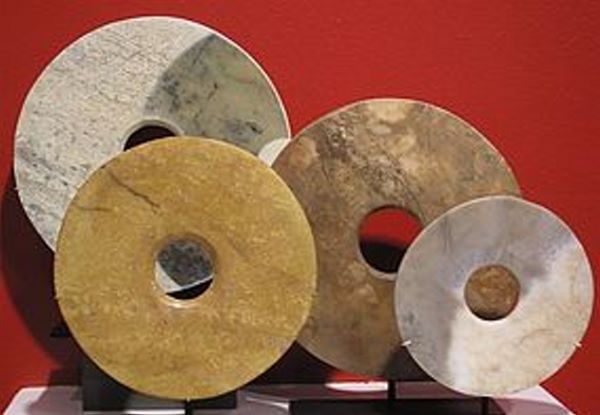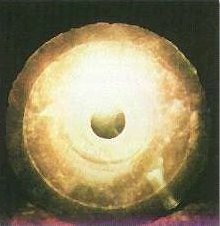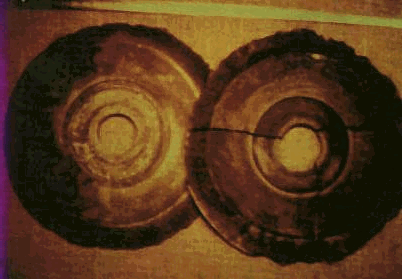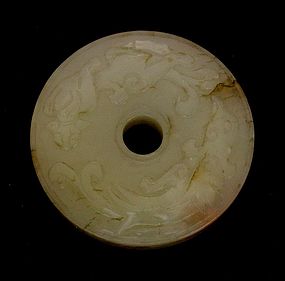|
 The Dropa Stone Discs:
(Bi-Disc's)
The Dropa Stone Discs:
(Bi-Disc's)
These carved stone discs have achieved notoriety
recently through the emergence of a story that claimed the
following:
 In
1938 a archaeological expedition led by a Professor Chi Pu
Tei, was exploring the Baian-Kara-ula
mountains in order to survey a series of interlinking caves on the
border of China and Tibet. What the team found was a cave within
which wee several small bodies, and over 700 small round stone
discs. They have since been claimed to be a record of an alien
crash-landing on earth 10,000 years ago. In
1938 a archaeological expedition led by a Professor Chi Pu
Tei, was exploring the Baian-Kara-ula
mountains in order to survey a series of interlinking caves on the
border of China and Tibet. What the team found was a cave within
which wee several small bodies, and over 700 small round stone
discs. They have since been claimed to be a record of an alien
crash-landing on earth 10,000 years ago.
Frustratingly, the
detailed facts of this case are not known as most of the literature
on this subject has been regurgitated from unsubstantiated sources.
|
The Dropa:
A Modern Myth.? |
The following
text has been compiled from various websites, and is
unsubstantiated in any way.
According to
the modern myth, the caves they found themselves in were suggested to have been artificially
carved, and were more like a complex system of tunnels and
underground storerooms. The walls were squared and glazed, as if
cut into the mountain with a source of extreme heat. Inside the
caves were several ancient, but neatly arranged burial sites,
and in them the skeletal remains of several small (measuring a little
more than four feet tall), frail and spindly people with
disproportionately large skulls. It is claimed that a member of
the team suggested that they might be the remains of an unknown
species of mountain gorilla to which Professor Chi Pu Tei is
reputed to have responded, "Who ever heard of apes burying one
another?"
On the walls of
the cave were said to be carved pictograms of
the heavens: the sun, the moon, the stars, and
the Earth with lines of dots connecting them.
(There is no image available to substantiate
this).
And half-buried in
the dirt floor of the cave was a stone disk,
obviously fashioned by the hand of an
intelligent creature. The disk was approximately
nine inches in diameter and three-quarters of an
inch thick. In the exact centre was a perfectly
round, 3/4" hole, and etched in its face was a
fine groove spiralling out from the centre to
the rim. This was the first of 716 such discs
retrieved from the cave.
It is said that
each disc had grooves on them, which upon
further inspection were found to be 'almost
microscopic' hieroglyphs. (There is also no
image available to substantiate this)
The discs
apparently remained in storage for the next 20
years at the Beijing university until 1962 when
another Chinese scientist called Dr. Tsum Um
Nui, working for the Prehistory Department of
the Beijing Academy declared that he had managed
to decipher the inscriptions, and had translated
the text on the discs. The professor wrote up a
paper on his findings and presented it to the
university for publication. Their reaction was
emphatic: the paper would not be published. The
Academy of Prehistory expressly forbade him to
publish or even speak of his findings for over
two years until he published the paper himself
(apparently against their will), as titled
below.
"The Grooved Script Concerning
Spaceships Which, as Recorded on the Discs, Landed on Earth 12,000 Years Ago."
(3)
The Dropa disks apparently tell the story of a space
probe from a distant planet that crash-landed in
the Baian-Kara-Ula mountains of the Himalayas.
The occupants of the spacecraft - the Dropa -
found refuge in the caves of the mountains.
Despite their peaceful intentions, the Dropa
were misunderstood by members of the Ham tribe
who were occupying neighbouring caves and who
hunted down the aliens and even killed some of
them. A translation of one of the passages says:
"The Dropa came down from the clouds in their
aircraft. Our men, women, and children hid in
the caves ten times before sunrise. When at last
they understood the sign language of the Dropa,
they realized that the newcomers had peaceful
intentions....". The stones go on to say how the Dropa were
unable to repair their disabled spacecraft and
could not return to their home planet, and so
were stranded on Earth.
Although Dr. Tsum Um Nui's
translation was generally ridiculed, in 1968 the Dropa stones came to the
attention of W. Saitsew, a Russian scientist who
re-published the findings of Tsum Um Nui and
conducted tests on the disks that revealed some
very peculiar properties. Physically, the
granite stones contained high concentrations of
cobalt and other metals - a very hard stone
indeed that would have made it difficult for the
primitive people to carve the lettering,
especially with such minute characters. When
testing a disk with an oscillograph, a
surprising oscillation rhythm was recorded as
if, the scientists said, they had once been
electrically charged or had functioned as
electrical conductors.
(3)
Today, the isolated area is
still inhabited by two
tribes of people who, in fact, call themselves
the Dropa and the Han. Anthropologists have been
unable to categorize either tribe into any other
known race; they are neither Chinese nor
Tibetan.
Both tribes are of pygmy stature,
adults measuring between 3-foot-6 and 4-foot-7
with an average height of 4-foot-2, and body
weights of 38 to 52 pounds. They are
yellow-skinned with thin bodies and
disproportionately large heads, corresponding to
the skeletal remains found in the caves in 1938.
They have sparse hair on their bodies and have
large eyes that are not Asian in aspect, but
have pale blue irises.
|

Photo taken by Dr. Karyl
Robin-Evans during his 1947 expedition
Dzopa ruling couple Hueypah-La (4 ft. tall) and Veez-La (3
ft. 4 in. tall).
|
Supposedly, there also is an ancient Chinese
tale that might bear-out the Dropa's claims. The
tale relates the story of a small, slender,
yellow-skinned people who descended to the Earth
from the clouds, and who were shunned by
everyone because of their ugliness.
Bi-Discs are a
recognised form of circular artefact from ancient China. The earliest
Bi
were produced in the
Neolithic period, mainly in Jade and particularly by the
Liangzhu culture (3400-2250
BC) (1). They were placed on or near the head of the deceased person.
Neolithic Bi-discs are undecorated, while those from more recent dates
tend to be more intricate in design.
It is found that these objects testify to early
stages of development of cosmological concepts that remained
important in Chinese culture during the Warring States and Han
periods: the notion of a covering sky (gaitian) that revolves
around a central axis, the cycle of the Ten Suns, and the use of an
early form of the carpenter's square. These objects were handled by
shamans who were the religious leaders of Liangzhu society and the
transmitters of cosmological knowledge.
(2)
A Selection of Images of
Bi Discs.






(Anomalous
Artefacts)
(Ooparts)
(Prehistoric
China Homepage)
|
 In
1938 a archaeological expedition led by a Professor Chi Pu
Tei, was exploring the Baian-Kara-ula
mountains in order to survey a series of interlinking caves on the
border of China and Tibet. What the team found was a cave within
which wee several small bodies, and over 700 small round stone
discs. They have since been claimed to be a record of an alien
crash-landing on earth 10,000 years ago.
In
1938 a archaeological expedition led by a Professor Chi Pu
Tei, was exploring the Baian-Kara-ula
mountains in order to survey a series of interlinking caves on the
border of China and Tibet. What the team found was a cave within
which wee several small bodies, and over 700 small round stone
discs. They have since been claimed to be a record of an alien
crash-landing on earth 10,000 years ago.





